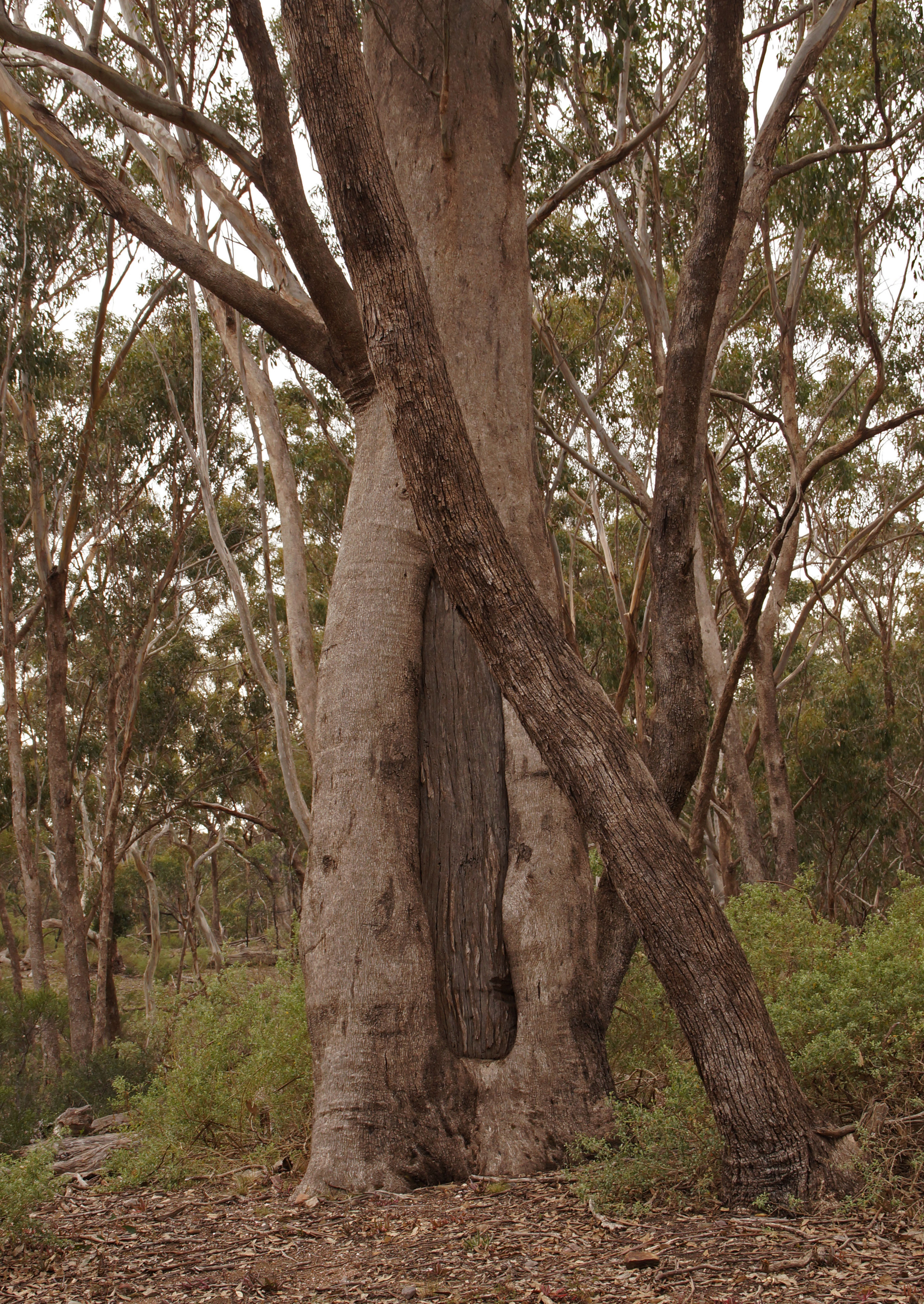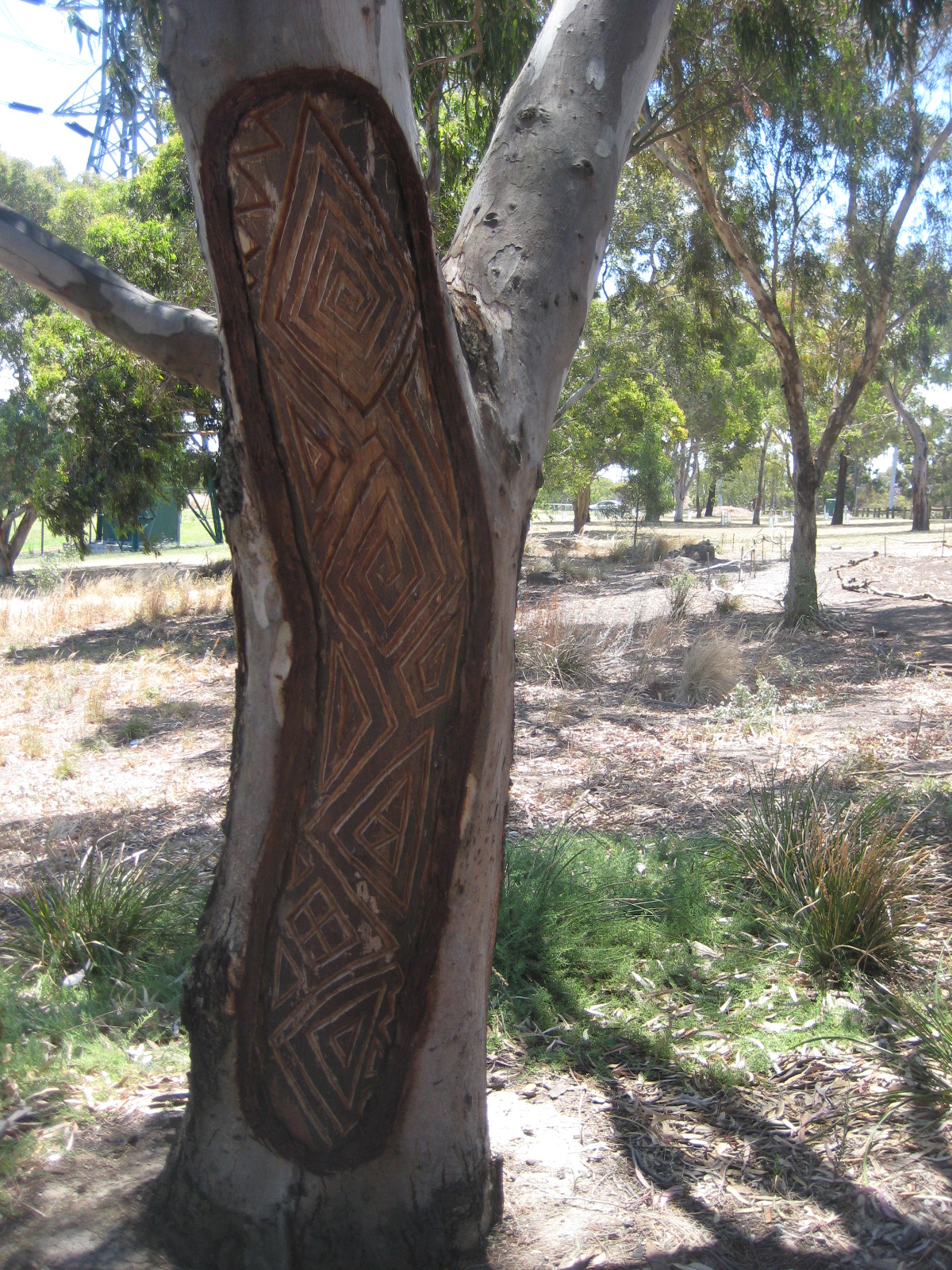Scarred tree on:
[Wikipedia]
[Google]
[Amazon]
A scarred tree or scar tree, also known as a canoe tree and shield tree, is a tree which has had bark removed by
 Bark was removed by making deep cuts in a tree with a stone pickaxe or other similar tool. The area of bark removed is typically regular in shape, often with parallel sides and slightly pointed or rounded ends, and the scar usually stops above ground level. Australian native
Bark was removed by making deep cuts in a tree with a stone pickaxe or other similar tool. The area of bark removed is typically regular in shape, often with parallel sides and slightly pointed or rounded ends, and the scar usually stops above ground level. Australian native


 Carved trees are mainly found in
Carved trees are mainly found in
Scarred Trees: An Identification and recording manual
{{Indigenous Australians Australian Aboriginal bushcraft History of Indigenous Australians
Aboriginal Australians
Aboriginal Australians are the various Indigenous peoples of the Australian mainland and many of its islands, such as Tasmania, Fraser Island, Hinchinbrook Island, the Tiwi Islands, and Groote Eylandt, but excluding the Torres Strait Isl ...
for the creation of bark canoes, shelters, weapons such as shields, tools, traps, containers (such as coolamons) or other artefacts. Carved trees are created as a form of artistic and spiritual expression by some Aboriginal peoples, to mark sites of significance such as burial sites.
Description
 Bark was removed by making deep cuts in a tree with a stone pickaxe or other similar tool. The area of bark removed is typically regular in shape, often with parallel sides and slightly pointed or rounded ends, and the scar usually stops above ground level. Australian native
Bark was removed by making deep cuts in a tree with a stone pickaxe or other similar tool. The area of bark removed is typically regular in shape, often with parallel sides and slightly pointed or rounded ends, and the scar usually stops above ground level. Australian native Eucalypt
Eucalypt is a descriptive name for woody plants with capsule fruiting bodies belonging to seven closely related genera (of the tribe Eucalypteae) found across Australasia:
''Eucalyptus'', ''Corymbia'', ''Angophora'', '' Stockwellia'', ''Allosyn ...
species such as box
A box (plural: boxes) is a container used for the storage or transportation of its contents. Most boxes have flat, parallel, rectangular sides. Boxes can be very small (like a matchbox) or very large (like a shipping box for furniture), and can ...
and red gum (especially in Victoria
Victoria most commonly refers to:
* Victoria (Australia), a state of the Commonwealth of Australia
* Victoria, British Columbia, provincial capital of British Columbia, Canada
* Victoria (mythology), Roman goddess of Victory
* Victoria, Seychelle ...
), or whichever species are native in the area. Scars remain in trees that are often over 200 years old. Sometimes there is exposed sapwood at the base or at the top of the scar, showing axe cuts.
Aboriginal people removed bark from trees to make things like canoes, containers and shields, as well as to build temporary shelters. Sometimes they cut toe hold
A leglock is a joint lock that is directed at joints of the leg such as the ankle, knee or hip joint. A leglock which is directed at joints in the foot, is sometimes referred to as a foot lock and a lock at the hip as a hip lock. Leglocks are feat ...
s for ease of climbing, with the trees used as lookout
A lookout or look-out is a person in charge of the observation of hazards. The term originally comes from a naval background, where lookouts would watch for other ships, land, and various dangers. The term has now passed into wider parlance.
...
s or to hunt for bush foods.
To remove bark, the Aboriginal people cut an outline of the shape they wanted using stone axes or, once Europeans had arrived, steel axes. The bark was then levered off. Sometimes the axe marks made by Aboriginal people are still visible on the sapwood of the tree, but usually the marks will be hidden because the bark has grown back. The amount of bark regrowth may help you tell the age of the scar. Sometimes, if the scar is very old, it will be completely covered by regrowth
Non-Indigenous Australians
Indigenous Australians or Australian First Nations are people with familial heritage from, and membership in, the ethnic groups that lived in Australia before British colonisation. They consist of two distinct groups: the Aboriginal peoples ...
called the trees thus marked as scarred trees, scar trees, canoe trees or shield trees.
In the 17th century, dugout canoe
A dugout canoe or simply dugout is a boat made from a hollowed tree. Other names for this type of boat are logboat and monoxylon. ''Monoxylon'' (''μονόξυλον'') (pl: ''monoxyla'') is Greek – ''mono-'' (single) + '' ξύλον xylon'' ( ...
technology appeared in Australia, to supplement the bark canoe, causing many changes to both the hunting practices and the society of the Aboriginal peoples.
Carved trees


New South Wales
)
, nickname =
, image_map = New South Wales in Australia.svg
, map_caption = Location of New South Wales in AustraliaCoordinates:
, subdivision_type = Country
, subdivision_name = Australia
, established_title = Before federation
, es ...
, and are the work specifically of Gamilaroi
The Gamilaraay, also known as Gomeroi, Kamilaroi, Kamillaroi and other variations, are an Aboriginal Australian people whose lands extend from New South Wales to southern Queensland. They form one of the four largest Indigenous nations in Aust ...
and Wiradjuri
The Wiradjuri people (; ) are a group of Aboriginal Australian people from central New South Wales, united by common descent through kinship and shared traditions. They survived as skilled hunter-fisher-gatherers, in family groups or clans, a ...
artists. They were created to mark sites of particular ceremonial significance, such as initiation or burial site
Burial, also known as interment or inhumation, is a method of final disposition whereby a dead body is placed into the ground, sometimes with objects. This is usually accomplished by excavating a pit or trench, placing the deceased and objec ...
s. They are also known as arborglyph
Arborglyphs, dendroglyphs, silvaglyphs, or modified cultural trees are carvings of shapes and symbols into the bark of living trees. Although most often referring to ancient cultural practices, the term also refers to modern tree-carving.
Love c ...
s, dendroglyphs and teleteglyphs.
During the 19th century, sections of these carved trees were removed and placed in museums, but there is now a move not only to return these trees to the land of origin, but also to revive the practice of carved trees.Locations
Scarred trees are found among mature native trees, especiallybox gum
''Eucalyptus odorata'', commonly known as peppermint box, is a species of mallee or a small tree that is endemic to South Australia. It has rough, hard bark on the trunk and larger branches, smooth greyish bark on the thinner branches, lance-sha ...
and red gum trees, along rivers and lakes and at sacred sites
Sacred space, sacred ground, sacred place, sacred temple, holy ground, or holy place refers to a location which is deemed to be sacred or hallowed. The sacredness of a natural feature may accrue through tradition or be granted through a bless ...
. They are protected by legislation.
Canoe trees have been photographed along the Murray River
The Murray River (in South Australia: River Murray) (Ngarrindjeri: ''Millewa'', Yorta Yorta: ''Tongala'') is a river in Southeastern Australia. It is Australia's longest river at extent. Its tributaries include five of the next six longest ...
at Waikerie
Waikerie ( ) is a rural town in the Riverland region of South Australia on the south bank of the Murray River. At the , Waikerie had a population of 2,684. The Sturt Highway passes to the south of the town at the top of the cliffs. There is a c ...
and Kroehns Landing at Nildottie in South Australia, and on the Murrumbidgee River
The Murrumbidgee River () is a major tributary of the Murray River within the Murray–Darling basin and the second longest river in Australia. It flows through the Australian state of New South Wales and the Australian Capital Territory, desce ...
near Hay, New South Wales
Hay is a town in the western Riverina region of south western New South Wales, Australia. It is the administrative centre of Hay Shire local government area and the centre of a prosperous and productive agricultural district on the wide Hay Pla ...
.
RMIT Bundoora, Victoria has six scarred trees on their campus. They have developed a self-guided tour trail or information can be found on their website.
See also
*Australian Aboriginal artefacts
Australian Aboriginal artefacts include a variety of cultural artefacts used by Aboriginal Australians. Most Aboriginal artefacts were multi-purpose and could be used for a variety of different occupations. Spears, clubs, boomerangs and shields ...
References
Further reading
* * – Canoe tree atCurrency Creek, South Australia
Currency Creek (postcode 5214) is a township and locality in South Australia on the western shore of Lake Alexandrina about 6 km north of Goolwa, beside a seasonal stream bearing the same name - Currency Creek - which flows into Lake Al ...
*
* – Gallery of photos of scar trees in New South Wales
)
, nickname =
, image_map = New South Wales in Australia.svg
, map_caption = Location of New South Wales in AustraliaCoordinates:
, subdivision_type = Country
, subdivision_name = Australia
, established_title = Before federation
, es ...
Scarred Trees: An Identification and recording manual
{{Indigenous Australians Australian Aboriginal bushcraft History of Indigenous Australians